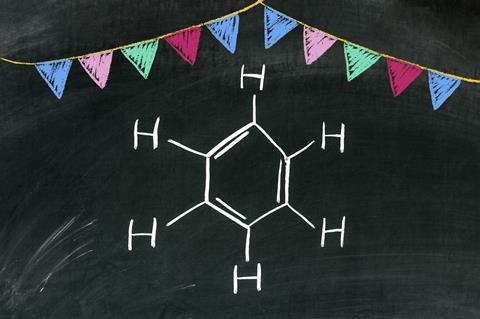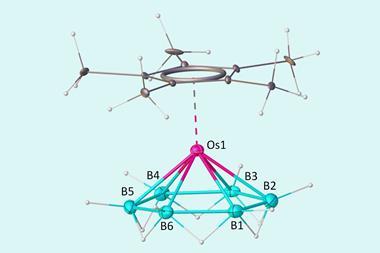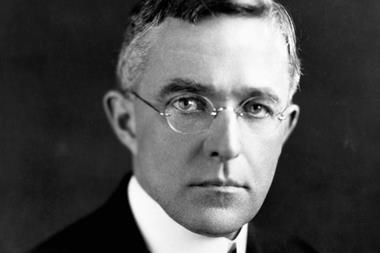Celebrating the molecule that changed the world

In 1825, Michael Faraday discovered one of the most fascinating compounds in chemistry: benzene. While isolating the components of oily residues of illuminating gas, Faraday identified a mysterious liquid, with a peculiar aromatic smell, which would go on to transform the landscape of chemistry.
Within the pages of the Philosophical Transactions of the Royal Society of London, Faraday described this seemingly simple yet profoundly unique molecule. What set benzene apart, even in its earliest discovery, was its resistance to easy chemical classification. Its peculiar behaviour, such as its surprising stability despite being highly unsaturated, hinted at a deeper mystery that would not be fully resolved until the mid-19th century with the proposal of its cyclic structure.
Benzene’s physical properties only added to its mystique. This colourless liquid emitted a faintly sweet, intoxicating aroma – a hallmark of aromatic compounds. With a boiling point of 80.1°C, it was volatile and highly flammable, making it both a chemical curiosity and a potential industrial tool. Early chemists were captivated by its ability to dissolve fats, oils and other nonpolar substances, which made it a valuable solvent for experimentation and industrial processes. Yet, it was benzene’s chemical properties – its reactivity and stability – that would become the cornerstone of an entire branch of organic chemistry: aromatic compounds.
Today, benzene is everywhere, interwoven into the structures of more complex molecules that enhance our daily lives in fields as diverse as health, energy, advanced materials, electronics, food, dyes and biotechnology. This humble molecule opened the doors to a vast universe of aromatic compounds and an endless array of applications that have redefined our world.
Stability and tunability
Following benzene’s legacy came polycyclic aromatic hydrocarbons (PAHs), a fascinating class of organic molecules composed of fused benzene rings. These structures not only preserve benzene’s aromatic stability, thanks to their electron delocalisation, but also exhibit unique electronic and optical properties determined by their size and arrangement. While smaller PAHs, like naphthalene and anthracene, had been characterised in the 19th century, the discovery of larger, more complex systems unveiled entirely new and surprising properties – from discrete energy levels in simpler molecules to semiconducting behaviours in larger systems like pentacene.
The synthesis and study of these compounds paved the way for nanographenes, opening new dimensions in chemistry and materials science. Through meticulous control over their molecular structures, researchers have learned to design advanced materials with tunable properties, such as electron conductivity, fluorescence, chirality and chemical reactivity. This painstaking precision highlights the intrinsic beauty of chemistry at its most fundamental level, an art of exactitude that continues to push the boundaries of possibility.
A landmark achievement in this journey was the discovery of hexabenzocoronene (HBC), in 1958. This molecule, composed of 42 carbon atoms forming 13 hexagonal rings in a perfectly flat structure, remained the largest fully characterised polycyclic aromatic hydrocarbon for decades. Yet the creativity of organic chemistry knows no bounds. Klaus Müllen, a pioneer in the exploration of nanographenes, succeeded in 2002 in synthesising a remarkable structure formed by 222 carbon atoms with a diameter of 3nm, demonstrating the immense potential of organic synthesis to construct tailor-made graphene molecules.
Graphene stands out as the ultimate expression of benzene’s versatility
The fusion of benzene rings has given rise to some of the most remarkable materials in modern science, including fullerenes and carbon nanotubes. Fullerenes, often referred to as buckyballs, are spherical molecules composed entirely of carbon atoms arranged in a pattern of hexagons and pentagons, resembling a molecular soccer ball. These structures, discovered in 1985, owe their stability and symmetry to the aromaticity derived from benzene-like rings. Similarly, carbon nanotubes – long, cylindrical structures composed of fused aromatic rings – have captivated scientists with their extraordinary strength, flexibility and electrical conductivity. Both fullerenes and nanotubes exemplify the limitless potential of carbon chemistry, with benzene as the foundational building block.
Among these innovations, graphene stands out as the ultimate expression of benzene’s versatility. This two-dimensional material, consisting of a single layer of carbon atoms arranged in a honeycomb lattice, is essentially a sheet of fused benzene rings. Graphene’s remarkable properties – its transparency, strength, flexibility and electrical conductivity – have earned it the title of a ‘gift of gods’. Graphene, like benzene before it, has the power to revolutionise multiple fields, from electronics and energy storage to medicine and materials science.
Beyond its scientific impact, benzene holds a special place in education. Generations of high school and university students have been introduced to the elegance of its structure and the profound mystery surrounding its stability. The study of benzene serves as an accessible entry point for understanding broader concepts like aromaticity, resonance and molecular orbitals. By celebrating the bicentennial of its discovery, we honour not only the legacy of Faraday but also the enduring role of benzene in inspiring curiosity, innovation and the next generation of chemists.
To celebrate the 200th anniversary of benzene’s discovery and its extraordinary legacy, the Royal Society of Chemistry will release a thematic special issue, uniting several RSC journals in a collaborative tribute to benzene’s unparalleled influence.
This special issue, edited by Ben Feringa and Nazario Martín, will illuminate the enduring relevance of benzene by exploring its far-reaching legacy in carbon-based systems, from the fundamental concepts of aromaticity and antiaromaticity to groundbreaking research on polycyclic aromatic hydrocarbons (PAHs), molecular nanographenes (via both top-down and bottom-up approaches), graphene and its derivatives, carbon nanotubes and fullerenes. It will also delve into cutting-edge developments from (anti)aromatic compounds synthesised through on-surface methodologies to benzene-based molecular machines.












2 readers' comments